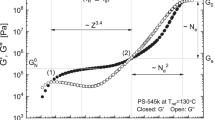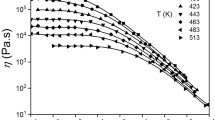Abstract
The focus of this paper is on the viscoelastic properties of concentrated polymer solutions and polymer melts. Dynamic mechanical measurements were performed on various polystyrene/ethylbenzene solutions with polymer concentrations ranging from 40% up to 100% and temperatures from Tg+30°C up to 70°C (230°C for polymer melts). The basis polymers are two commerical grade polystyrenes (BASF) with M W = 247 kg/mol and 374 kg/mol, respectively. To avoid solvent loss due to evaporating during the measurements, a special sealing technique was used.
A phenomenological model which describes quantitatively the relaxation spectrum of concentrated polymer solutions from the flow regime up to the glass transition regime is developed. The relaxation data of the respective polymer melt and the glass transition temperature of the solution are the only input parameters needed. The temperature dependence is described by a universal, concentration invariant WLF-equation. The relaxation spectra are divided into two parts accounting for the entanglement and the segmental relaxation modes, respectively. The relaxation strength related to the flow and entanglement regime scale with c 2.3, whereas the segmental relaxation strength does not alter with concentration. All relaxation times change with concentration proportional to c 3.5. Flow curves can be calculated from these relaxation spectra and thus, our results are useful for engineering applications.
Similar content being viewed by others
Abbreviations
- a T :
-
Time temperature superposition shift - factor
- a c :
-
Time concentration superposition - shift factor in the flow regime
- a′ c :
-
Time concentration superposition - shift factor in the glassy regime
- b T :
-
Modulus temperature superposition - shift factor
- b c :
-
Modulus concentration shift factor - in the flow regime
- b′ c :
-
Modulus concentration shift factor - in the glassy regime
- B :
-
Virial coefficients
- c :
-
Polymer mass fraction kg/kg
- c 1 :
-
WLF-parameter
- c2:
-
WLF-parameter K
- g :
-
Relaxation strength of a relaxation Pa mode
- G(t):
-
Relaxation modulus Pa
- G′:
-
Storage modulus Pa
- G″:
-
Loss modulus Pa
- GN :
-
Plateau modulus of linear flexible Pa polymers
- δ(x):
-
Delta function: δ(0) = 1, - δ(x<>0)=0
- h(γ):
-
Damping function
- H(λ):
-
Relaxation spectrum Pa
- J N0 :
-
Recoverable compliance Pa−1
- m :
-
Mass kg
- M c :
-
Critical molecular weight kg/mol
- M e :
-
Entanglement molecular weight kg/mol
- M w :
-
Weight average molecular weight kg/mol
- M :
-
Number of datapoints
- n :
-
Scaling exponent
- N :
-
Number of discrete relaxation modes
- T :
-
Temperature °C
- T g :
-
Glass transition temperature °C
- V :
-
Volume 1
- α:
-
Scaling exponent
- α f :
-
Thermal expansion coefficient K−1
- β:
-
Scaling exponent
- γ:
-
Shear deformation
- γ:
-
Shear rate st−1
- λ:
-
Relaxation time s
- λ c :
-
Characteristic relaxation time of thes Cross model
- λ e :
-
Entanglement relaxation time s
- η:
-
Viscosity Pa s
- η0 :
-
Zero shear viscosity Pa s
- Ψ0 :
-
First normal stress coefficientPa s2
- ζ:
-
Segmental friction coefficient
- ω:
-
Frequency rad/s
- f :
-
Flow and entanglement regime
- g :
-
Glass transition regime
- i :
-
Count parameter
- p :
-
Polymer
- ref :
-
Reference state
- s :
-
Solvent
References
Barlow AJ, Erginsay A, Lamb J (1967) Viscoelastic relaxation of supercooled liquids. Proc Re Soc A 298:481
Baumgärtel M, Winter HH (1989) Determination fo the discrete relaxation and retardation time spectrum from dynamic mechanical data. Rheol Acta 28:511
Baumgärtel M, Schausberger A, Winter HH (1990) The relaxation of polymers with linear flexible chains of uniform length. Rheol Acta 29:400
Baumgärtel M (1992) The relaxation of linear flexible polymers: correlation between molar mass distribution and rheological data of polymer melts. Ph. D. Thesis, Univ. of Mass. USA
Berry GC (1966) The viscosity of polymer diluent mixtures. J Phys Chem 70:1194–1198
Bouldin M, Kilicke W-M, Kehler H (1988) Prediction of the non-Newtonian viscosity and shear stability of polymer solutions. Colloid Polym Sci 266:793
Braun G, Kovacs AJ (1965) Proceedings of the conference on physic of non-crystallines solids, Prins JA, ed. Amsterdam, North-Holland
Bueche F (1962) Physical properties of polymers. Interscience
Cox WP, Merh EH (1958) Correlation of dynamic and steady viscosity. J Polym Sci 28:612
Cross MM (1968) In: Wetton RE, Whorlow RW (eds) Polymer systems: deformation and flow. Macmillan, London
Doi M, Edwards SF (1978) Dynamics of concentrated polymeric systems. J Chem Soc Farady Trans II 74:1789, 1802, 1818
Faerber GL, Kim SW, Eyring H (1970) The viscous flow and glass transition of some hydrocarbons. J Phys Chem 74:3510–3518
Ferry JD (1980) Viscoelastic properties of polymers, 3rd ed. Wiley, New York
Fukuda M, Osaki K, Kurata M (1975) Nonlinear viscoelasticity of polystyrene solutions. J Polym Sci, Polym Phys Ed 13:1563–1576
de Gennes PG (1971) Reptation of apolymer chain in the presence of fixed obstacles. J Chem Phys 55:572
Gleissle W (1980) Two simple time shearrate relations combining viscosity and first normal stress coefficient in the linear and nonlinear flow range. Rheology Band II, Astarita, Marrucci, Nicolais (eds) Plenum Press, New York
Graessley WW, Hazleton RL, Lindeman LR (1967) The shear-rate dependence of viscosity in concentrated solutions of narrow-distributed polystyrene. Trans Soc Rheol 11(3):267–285
Grassley WW (1974) The entanglement concept in polymer rheology. Advances in Polymer Science 16
Graessley WW, Edwards SF (1981) Entanglement interaction in polymers and the chain contour concentration. Polymer 22:1329
Graessley WW (1986) In: Forsman WC (ed) Polymers in solution. Plenum Press, New York
Harkness MR (1982) Ph. D.Thesis, Rensselaer Polytechnic Institute at Troy
Holmes LA, Kusamizu S, Osaki K, Ferry JD (1971) Dynamic mechanical properties of moderately concentrated polystyrene solutions. J Polym Sci A2, 9:2009
Kelley FN, Bueche F (1971) J Polym Sci 50:549–556
Kim DM, Naumann EB (1992) Solution viscosity of polystyrene at conditions aplicable to commercial manufacturing processes. J Chem Eng Data 37:427
Kulicke W-M, Kniewske R (1984) The shear viscosity dependence on concentration, molecular weight, and shear rate of polystyrene soluions. Rheol Acta 23:75
Kroger M, Hess S (1993) Viscoelasticity of polymeric melts and concentrated solutions. The effect of flow-induced alignment of chain ends. Physica A 195:336–353
Larson R (1987) Constitutive equations for polymer melts and solutions. Butterworths, London
Mendelson RA (1980) Concentrated solution viscosity behavior at elevated temperatures — polystyrene in ethylbenzene. J Rheol 24:765–781
Osaki K, Fukuda M, Kurata M (1975) Relaxation spectra of concentrated polystyrene solutions. J Polym Sci, Polym Phys Ed 13:775–786
Osaki K (1993) On the damping function of shear relaxation modulus for entangledpolymers. Rheol Acta 32:429–437
Pearson DS (1987) Recent advances in the molecular aspects of polymer viscoelasticity. Rubb Chem Tech 60:437
Richards WD, Prud'Homme RK (1986) The viscosity of concentrated polymer solutions containing low molecular weight solvents. J Appl Polym Sci 31:763
Rieger J (1995) Bestimmung der Glastemperatur mittels DSC. Kunststoffe 85:528–530
Vogel H (1921) Das Temperaturabhängig-keitsgesetz der Viskosität von Flüssigkeiten. Physik Zeitschr XXII:645
Williams ML, Landel RF, Ferry JD (1955) The temperature dependence of relaxation mechanisms in amorphous polymers and other glass-forming liquids. J Am Chem Soc 77:3701
Author information
Authors and Affiliations
Additional information
Dedicated to Prof. Dr. J. Meissner on the occasion of his retirement from the chair of Polymer Physics at the Eidgenössische Technische Hochschule (ETH) Zürich, Switzerland
Rights and permissions
About this article
Cite this article
Baumgärtel, M., Willenbacher, N. The relaxation of concentrated polymer solutions. Rheol Acta 35, 168–185 (1996). https://doi.org/10.1007/BF00396044
Received:
Accepted:
Issue Date:
DOI: https://doi.org/10.1007/BF00396044




